Midea Kitchen Appliances EM044KYYBBY Microwave Oven User Manual OR7 NEW Model EN 4 indd
Guangdong Midea Kitchen Appliances Manufacturing Co.,Ltd Microwave Oven OR7 NEW Model EN 4 indd
user manual

TABLE OF CONTENTS
All about the
Use & Care
of your Microwave Oven
OR7_NEW Model_EN-4.indd 1 09.4.28 11:46:16 AM
IMPORTANT SAFETY INSTRUCTIONS ......................2
PART NAMES ........................................................8
BEFORE OPERATING ...........................................10
COOKING .............................................1
MANUAL COOKING .............................................. 11
AUTO
CLEANING AND CARE ..........................................19
SPECIFICATIONS.................................................
....
22
8
Model:EM044K6BB-P0HK

2
IMPORTANT SAFETY INSTRUCTIONS
For your safety the information in this manual must be followed to minimize the risk
of fi re or explosion or to prevent property damage, personal injury or loss of life.
(a) Do not attempt to operate this oven with the door open since open-door operation can result in harmful exposure to
microwave energy. It is important not to defeat or tamper with the safety interlocks.
(b) Do not place any object between the oven front face and the door or allow soil or cleaner residue to accumulate on
sealing surfaces.
(c) Do not operate the oven if it is damaged. It is particularly important that the oven door close properly and that
there is no damage to the: (1) door (bent), (2) hinges and latches (broken or loosened), (3) door seals and
sealing surfaces.
(d) The oven should not be adjusted or repaired by anyone except properly qualifi ed service personnel.
PRECAUTIONS TO AVOID POSSIBLE
EXPOSURE TO EXCESSIVE
MICROWAVE ENERGY
OR7_NEW Model_EN-4.indd 2 09.4.28 11:46:18 AM
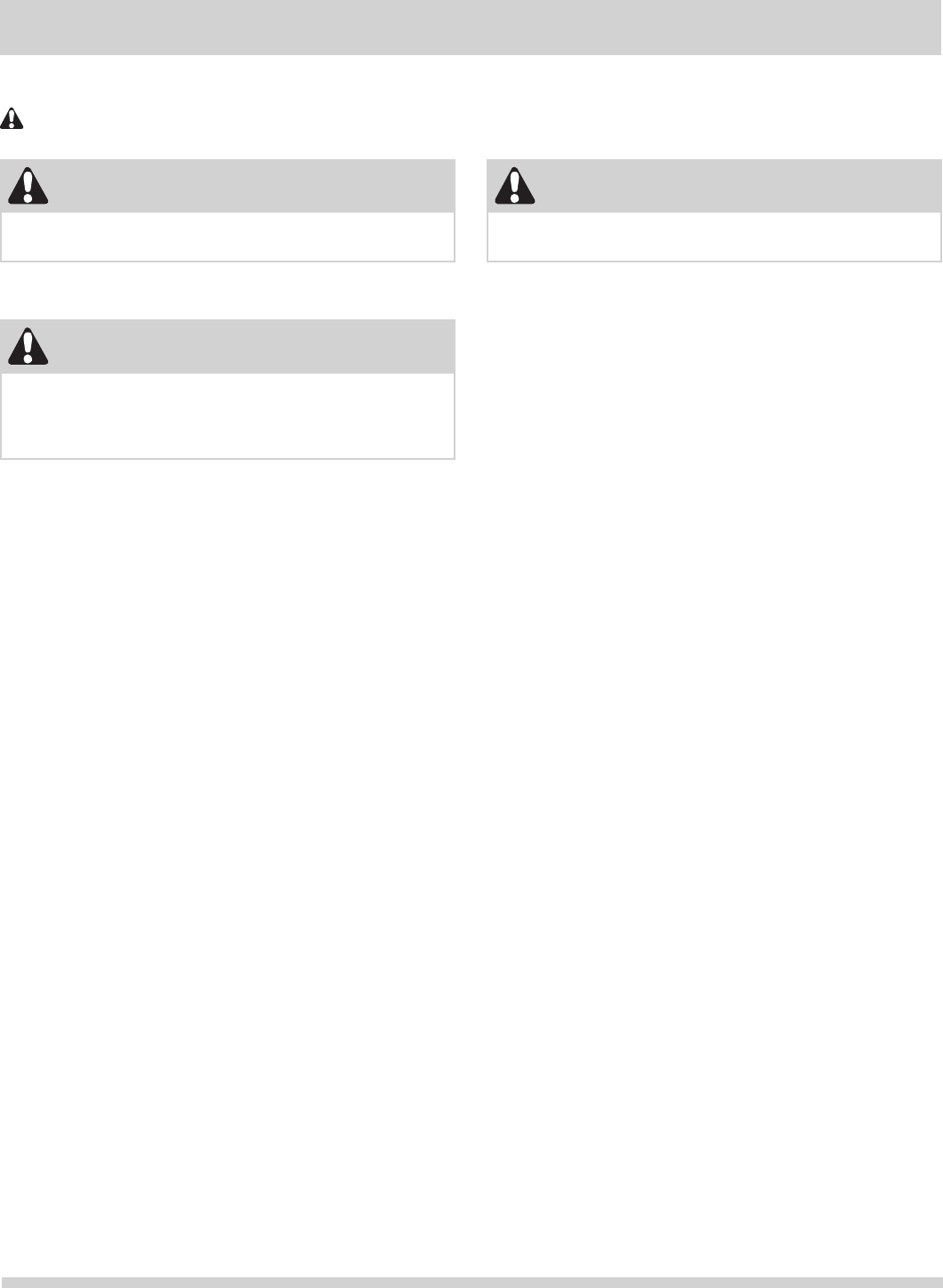
3
IMPORTANT SAFETY INSTRUCTIONS
• Read all instructions before using the appliance.
• Read and follow the specifi c “PRECAUTIONS TO
AVOID POSSIBLE EXPOSURE TO EXCESSIVE
MICROWAVE ENERGY” on page 2.
• This appliance must be grounded. Connect only
to properly grounded outlet. See “GROUNDING
INSTRUCTIONS” on page 4.
• Install or locate this appliance only in accordance with
the provided installation instructions.
• Some products such as whole eggs and sealed containers
—for example, closed glass jars—are able to explode
and should not be heated in this microwave oven.
• Use this appliance only for its intended use as described
in this manual. Do not use corrosive chemicals or
vapors in this appliance. This type of microwave oven is
specifi cally designed to heat, cook or dry food. It is not
designed for industrial or laboratory use.
• As with any appliance, close supervision is necessary
when used by children.
• Do not operate this appliance if it has a damaged cord
or plug, if it is not working properly or if it has been
damaged or dropped.
• This appliance should be serviced only by qualifi ed
service personnel. Contact nearest Electrolux Authorized
Servicer for examination, repair or adjustment.
• Do not cover or block any openings on the appliance.
• Do not store or use this appliance outdoors. Do not use
this product near water—for example, near a kitchen
sink, in a wet basement or near a swimming pool, or
similar locations.
• Do not immerse cord or plug in water.
• Keep cord away from heated surfaces.
• Do not let cord hang over edge of table or counter.
• See door surface cleaning instructions on page 23.
• To reduce the risk of fi re in the microwave oven cavity:
- Do not overcook food. Carefully attend
appliance when paper, plastic or other
combustible materials are placed inside the
microwave oven to facilitate cooking.
- Remove wire twist-ties from paper or plastic bags
before placing bag in microwave oven.
- If materials inside the microwave oven ignite,
keep microwave oven door closed, turn
microwave oven off and disconnect the power
cord or shut off power at the fuse or circuit
breaker panel.
- Do not use the cavity for storage purposes. Do not
leave paper products, cooking utensils or food in the
cavity when not in use.
•
Liquids, such as water, coffee or tea are able to be
overheated beyond the boiling point without appearing to
be boiling. Visible bubbling or boiling when the container
is removed from the microwave oven is not always
present. THIS COULD RESULT IN VERY HOT LIQUIDS
SUDDENLY BOILING OVER WHEN A SPOON OR
OTHER UTENSIL IS INSERTED INTO THE LIQUID.
To reduce the risk of injury to persons:
- Do not overheat the liquid.
-
Stir the liquid both before and halfway through heating it.
- Do not use straight-sided containers with narrow
necks. Use a wide-mouthed container.
- After heating, allow the container to stand in the
microwave oven at least for 20 seconds before
removing the container.
- Use extreme care when inserting a spoon or other
utensil into the container.
•
Clean ventilation openings and grease fi lters frequently.
Grease should not be allowed to accumulate on
ventilation openings, louver or grease fi lters.
•
Use care when cleaning the louver and the grease fi lters.
Corrosive cleaning agents, such as lye-based oven
cleaners, may damage the louver and the grease fi lters.
• When fl aming food under the hood, turn the fan on.
• This appliance is suitable for use above both gas and
electric cooking equipment 36” wide or less.
READ ALL INFORMATION BEFORE USING
SAVE THESE INSTRUCTIONS.
WARNING
To reduce the risk of fi re, burns, electric shock, injury
to persons, or exposure to excessive microwave energy
when using your appliance, follow basic precautions,
including the following sections.
WARNING
WARNING indicates a potentially hazardous situation which,
if not avoided, could result in death or serious injury.
CAUTION
CAUTION indicates a potentially hazardous situation which,
if not avoided, may result in minor or moderate injury.
Defi nitions
This is the safety alert symbol. It is used to alert you to potential personal injury hazards. Obey all safety messages
that follow this symbol to avoid possible injury or death.
OR7_NEW Model_EN-4.indd 3 09.4.28 11:46:18 AM
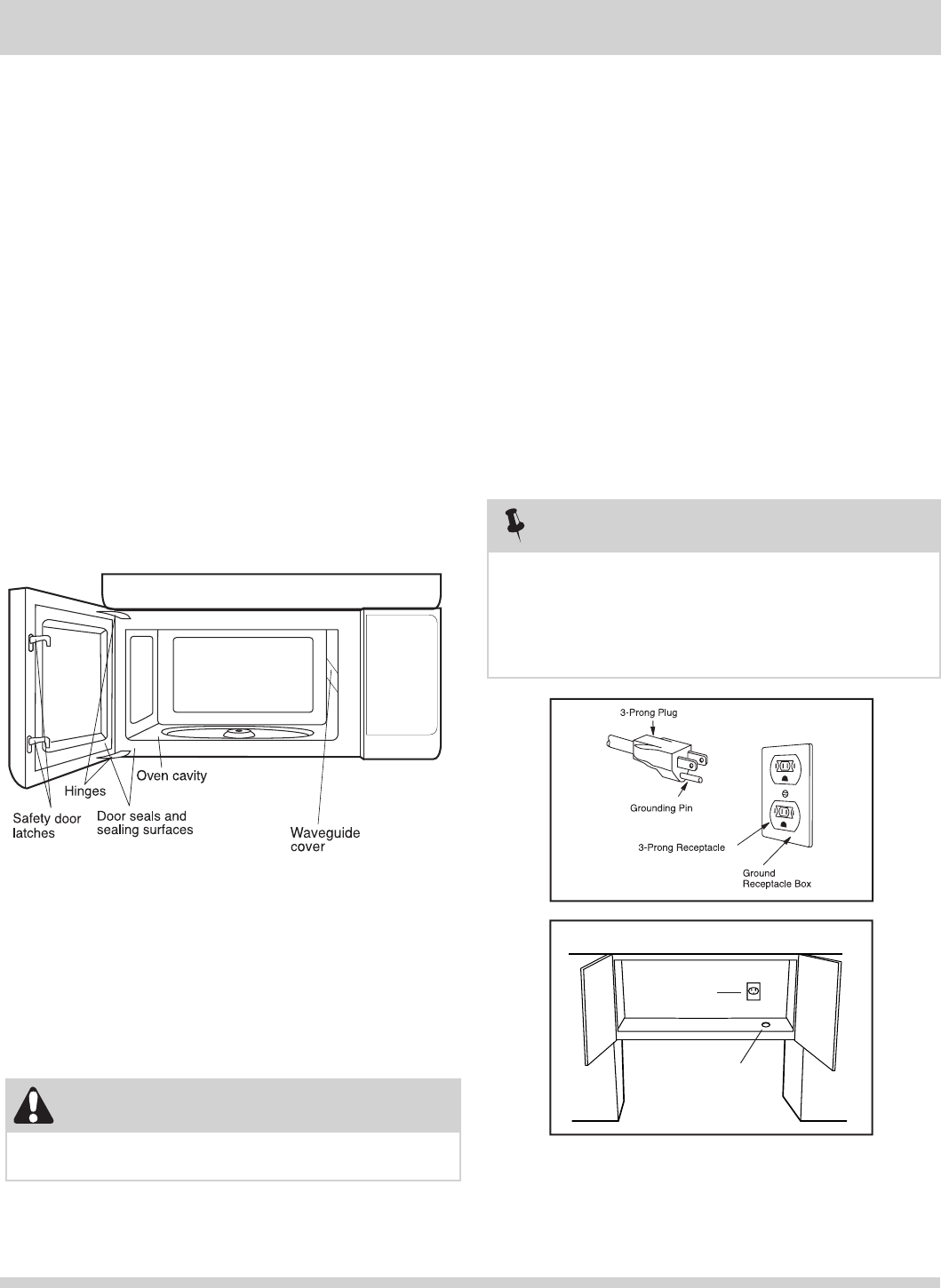
4
IMPORTANT SAFETY INSTRUCTIONS
Electrical Requirements
Check Installation Instructions for proper location for the
power supply.
The electrical requirements are a 120 volt 60 Hz, AC
only, 15 amp. or more protected electrical supply. It is
recommended that a separate circuit serving only the
microwave oven be provided.
The microwave oven is equipped with a 3-prong
grounding plug. It must be plugged into a wall receptacle
that is properly installed and grounded. DO NOT
UNDER ANY CIRCUMSTANCES CUT OR REMOVE THE
GROUNDING PIN FROM THE PLUG.
DO NOT USE AN EXTENSION CORD.
If the power supply cord is too short, have a qualifi ed
electrician or serviceman install an outlet near the appliance.
The Power Supply Cord and plug must be connected to
a separate 120 Volt AC, 60 Hz, 15 Amp, or more branch
circuit, single grounded receptacle. The receptacle
should be located inside the cabinet directly above the
Microwave Oven mounting location as shown in Figure 1.
Figure 1
Ground
Receptacle
Opening for
Power Cord
WARNING
Improper use of the grounding plug can result in a risk
of electric shock.
NOTES
1.
If you have any questions about the grounding or electrical
instructions, consult a qualifi ed electrician or service person.
2. Neither Electrolux nor the dealer can accept any
liability for damage to the microwave oven or
personal injury resulting from failure to observe the
correct electrical connection procedures.
GROUNDING INSTRUCTIONS
This appliance must be grounded. This microwave oven
is equipped with a cord having a grounding wire with a
grounding plug. It must be plugged into a wall receptacle
that is properly installed and grounded in accordance
with the National Electrical Code and local codes and
ordinances. In the event of an electrical short circuit,
grounding reduces risk of electric shock by providing an
escape wire for the electric current.
UNPACKING AND EXAMINING YOUR
MICROWAVE OVEN
Open the bottom of the carton, bend the carton fl aps
back and tilt the microwave oven over to rest on plastic
foam pad. Lift carton off microwave oven and remove
all packing materials, Installation Instructions, Wall
Template, Top Template, Charcoal Filter, Turntable and
Turntable Support. SAVE THE CARTON AS IT MAY MAKE
INSTALLATION EASIER.
• Remove the feature sticker from the outside of the
door, if there is one.
•
DO NOT REMOVE THE WAVEGUIDE COVER.
Check to see that there are Installation Instructions,
Wall Template, Top Template and Charcoal Filter, which
is used when recirculating is chosen. Read enclosures
and SAVE the Use and Care Manual.
Check the microwave oven for any damage, such as
misaligned or bent door, damaged door seals and sealing
surfaces, broken or loose door hinges and latches and
dents inside the cavity or on the door. If there is any
damage, do not operate the microwave oven and contact
your dealer or ELECTROLUX SERVICER. See Installation
Instructions for more details.
OR7_NEW Model_EN-4.indd 4 09.4.28 11:46:19 AM

5
IMPORTANT SAFETY INSTRUCTIONS
Federal Communications Commission Radio Frequency Interference Statement
(U.S.A. Only)
This equipment generates and uses ISM frequency energy and if not installed and used properly, that is in strict accordance
with the manufacturer's instructions, may cause interference to radio and television reception. It has been type tested
and found to comply with limits for ISM Equipment pursuant to part 18 of FCC Rules, which are designed to provide
reasonable protection against such interference in a residential installation.
However, there is no guarantee that interference will not occur in a particular installation.
If this equipment does cause
interference to radio or television reception, which can be determined by turning the equipment off and on, the user is encouraged
to try to correct the interference by one or more of the following:
• Reorient the receiving antenna of the radio or television.
•
Relocate the microwave oven with respect to the receiver.
• Move the microwave oven away from the receiver.
•
Plug the microwave oven into a different outlet so that the microwave oven and the receiver are on different branch
circuits.
The manufacturer is not responsible for any radio or television interference caused by unauthorized modifi cation
to this microwave oven. It is the responsibility of the user to correct such interference.
OR7_NEW Model_EN-4.indd 5 09.4.28 11:46:19 AM

6
IMPORTANT SAFETY INSTRUCTIONS
ABOUT YOUR MICROWAVE OVEN
This Use and Care Manual is valuable: read it carefully and
always save it for reference.
A good microwave cookbook is a valuable asset. Check it for
microwave cooking principles, techniques, hints and recipes.
NEVER use the microwave oven without the turntable and
support nor turn the turntable over so that a large dish could
be placed in the microwave oven. The turntable will turn both
clockwise and counterclockwise. See page 23 for complete
instructions.
ALWAYS have food in the microwave oven when it is on to
absorb the microwave energy.
When using the microwave oven at power levels below 100%,
you may hear the magnetron cycling on and off. It is normal
for the exterior of the microwave oven to be warm to the touch
when cooking or reheating.
Condensation is a normal part of microwave cooking. Room
humidity and the moisture in food will infl uence the amount
of moisture that condenses in the microwave oven. Generally,
covered foods will not cause as much condensation as
uncovered ones. Ventilation openings must not be blocked.
The microwave oven is for food preparation only. It should not
be used to dry clothes or newspapers.
Your microwave oven is rated 1000 watts by using the IEC
Test Procedure. In using recipes or package directions, check
food a minute or two before the minimum time and add time
accordingly.
ABOUT MICROWAVE COOKING
•
Arrange food carefully. Place thickest areas towards outside of dish.
• Watch cooking time. Cook for the shortest amount of
time indicated and add more as needed. Food severely
overcooked can smoke or ignite.
•
Cover foods while cooking. Check recipe or cookbook for
suggestions: paper towels, wax paper, microwave plastic wrap or
a lid. Covers prevent spattering and help foods to cook evenly.
• Shield with small fl at pieces of aluminum foil any thin areas
of meat or poultry to prevent overcooking before dense, thick
areas are cooked thoroughly.
• Stir foods from outside to center of dish once or twice during
cooking, if possible.
• Turn foods over once during microwaving to speed cooking
of such foods as chicken and hamburgers. Large items like
roasts must be turned over at least once.
• Rearrange foods such as meatballs halfway through cooking
both from top to bottom and from the center of the dish to
the outside.
• Add standing time. Remove food from microwave oven and
stir, if possible. Cover for standing time which allows the food
to fi nish cooking without overcooking.
• Check for doneness. Look for signs indicating that cooking
temperatures have been reached.
Doneness signs include:
- Food steams throughout, not just at edge.
- Center bottom of dish is very hot to the touch.
- Poultry thigh joints move easily.
- Meat and poultry show no pinkness.
- Fish is opaque and fl akes easily with a fork.
ABOUT FOOD
• Cook eggs in shells.
• Reheat whole eggs.
• Dry nuts or seeds in shells.
• Pop popcorn in regular brown bags or glass bowls.
• Exceed maximum time on popcorn package.
• Heat disposable bottles.
• Heat bottles with nipples on.
• Heat baby food in original jars.
• Heat or cook in closed glass jars or air tight
containers.
• Can in the microwave as harmful bacteria may not
be destroyed.
• Deep fat fry.
• Dry wood, gourds, herbs or wet papers.
Eggs,
sausages,
nuts, seeds,
fruits &
vegetables
Popcorn
Baby food
General
FOOD DO DON’T
• Puncture egg yolks before cooking to prevent
“explosion”.
• Pierce skins of potatoes, apples, squash, hot dogs
and sausages so that steam escapes.
•
Use specially bagged popcorn for microwave cooking.
• Listen while popping corn for the popping to slow
to 1 or 2 seconds or use special popcorn pad.
• Transfer baby food to small dish and heat carefully,
stirring often. Check temperature before serving.
• Put nipples on bottles after heating and shake
thoroughly. “Wrist” test before feeding.
• Cut baked goods with fi
lling after heating to release
steam and avoid burns.
• Stir liquids briskly before and after heating to avoid
“eruption”.
• Use deep bowl, when cooking liquids or cereals, to
prevent boilovers.
OR7_NEW Model_EN-4.indd 6 09.4.28 11:46:20 AM

7
ABOUT CHILDREN AND THE MICROWAVE
Children below the age of 7 should use the microwave oven with
a supervising person very near to them. Between the ages of 7
and 12, the supervising person should be in the same room.
As with any appliance, close supervision by an adult is
necessary when used by children.
At no time should anyone be allowed to lean or swing on the
microwave oven door.
Children should be taught all safety precautions: use
potholders, remove coverings carefully, pay special attention to
packages that crisp food because they may be extra hot.
Don’t assume that because a child has mastered one cooking
skill he/she can cook everything.
Children need to learn that the microwave oven is not a toy. See
page 20 for Child Lock feature.
ABOUT SAFETY
• ALWAYS use potholders to prevent burns when handling
utensils that are in contact with hot food. Enough heat from
the food can transfer through utensils to cause skin burns.
• Avoid steam burns by directing steam away from the face and
hands. Slowly lift the farthest edge of a dish’s covering and carefully
open popcorn and oven cooking bags away from the face.
• Stay near the microwave oven while it’s in use and check
cooking progress frequently so that there is no chance of
overcooking food.
• NEVER use the cavity for storing cookbooks or other items.
• Select, store and handle food carefully to preserve its high
quality and minimize the spread of foodborne bacteria.
• Keep waveguide cover clean. Food residue can cause arcing
and/or fi res.
• Use care when removing items from the microwave oven so
that the utensil, your clothes or accessories do not touch the
safety door latches.
• Keep aluminum foil used for shielding at least 1 inch away
from walls, ceiling and door.
IMPORTANT SAFETY INSTRUCTIONS
ABOUT UTENSILS AND COVERINGS
It is not necessary to buy all new cookware. Many pieces already in your
kitchen can be used successfully in your new microwave oven. Make
sure the utensil does not touch the interior walls during cooking.
Use these utensils for safe microwave
cooking and reheating:
• glass ceramic (Pyroceram®), such as Corningware®.
• heat-resistant glass (Pyrex®)
• microwave-safe plastics
• paper plates
• microwave-safe pottery, stoneware and porcelain
• browning dish (Do not exceed recommended preheating time.
Follow manufacturer’s directions.)
These items can be used for short time reheating
of foods that have little fat or sugar in them:
• wood, straw, wicker
DO NOT USE
• metal pans and bakeware
• dishes with metallic trim
• non-heat-resistant glass
• non-microwave-safe plastics (margarine tubs)
• recycled paper products
• brown paper bags
• food storage bags
• metal twist-ties
Should you wish to check if a dish is safe for microwaving, place
the empty dish in the microwave oven and microwave on HIGH for
30 seconds. A dish which becomes very hot should not be used.
The following coverings are ideal:
• Paper towels are good for covering foods for reheating and
absorbing fat while cooking bacon.
• Wax paper can be used for cooking and reheating.
• Plastic wrap that is specially marked for microwave use can
be used for cooking and reheating. DO NOT allow plastic
wrap to touch food. Vent so steam can escape.
• Lids that are microwave-safe are a good choice because heat
is kept near the food to hasten cooking.
• Microwave oven cooking bags are good for large meats or
foods that need tenderizing. DO NOT use metal twist ties.
Remember to slit bag so steam can escape.
How to use aluminum foil in your
microwave oven:
•
Small fl at pieces of aluminum foil placed smoothly on the food can be
used to shield areas that are either defrosting or cooking too quickly.
• Foil should not come closer than one inch to any surface of
the microwave oven.
Should you have questions about utensils or coverings, check a
good microwave cookbook or follow recipe suggestions.
OR7_NEW Model_EN-4.indd 7 09.4.28 11:46:20 AM
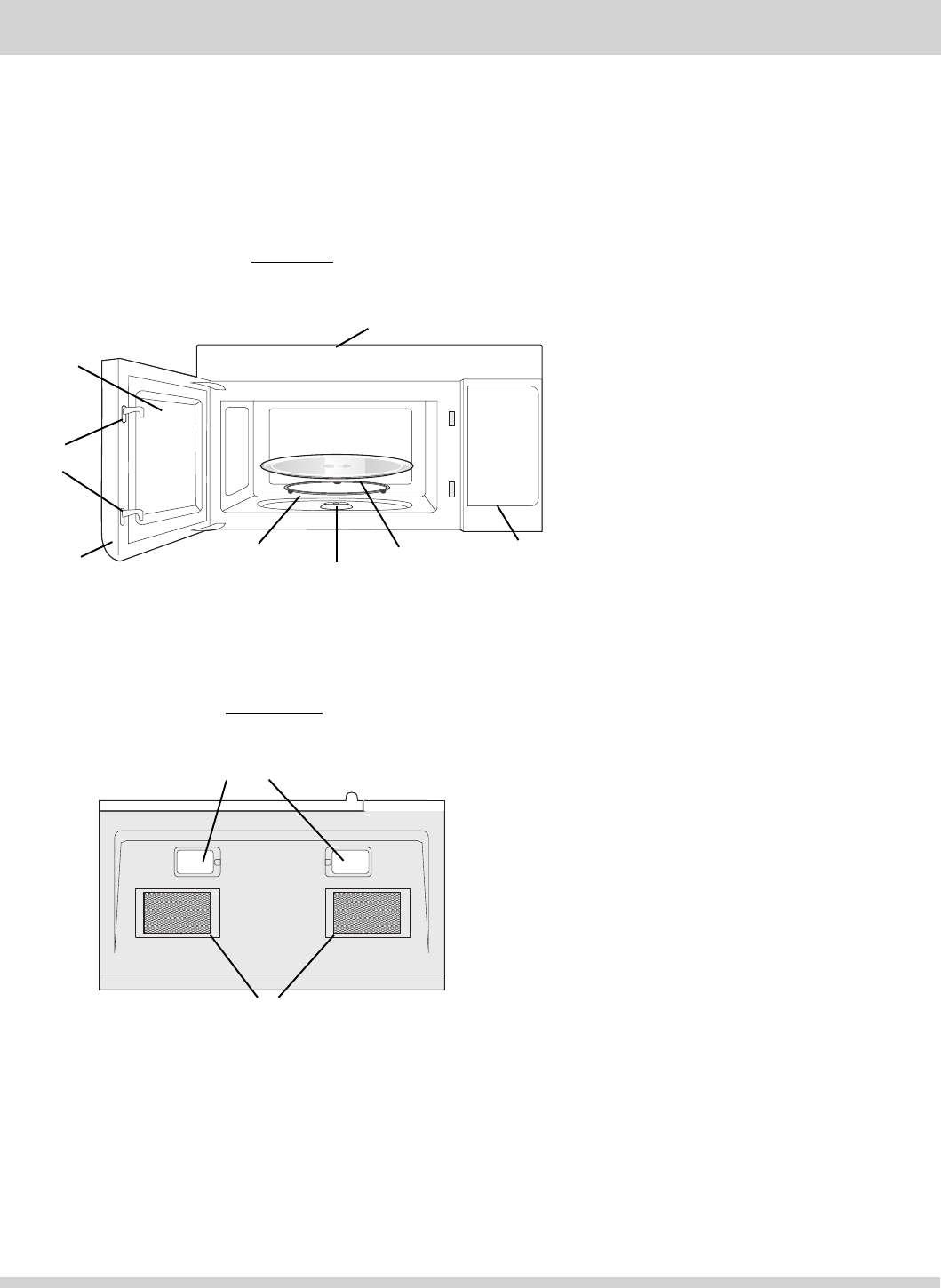
8
PART NAMES
1
2
4
5
6
7
9
10
OR7_NEW Model_EN-4.indd 8 09.4.28 11:46:20 AM
3
Microwave features
Turntable Shaft
Turntable ring assembly
Turntable glass tray
Control panel
Door assembly
Window
Interlock system
Front View
Bottom View
Front
Rear
Surface lights
Ventilation filters
Ventilation openings (on top)
8
1
2
34 56 7
8
9
10
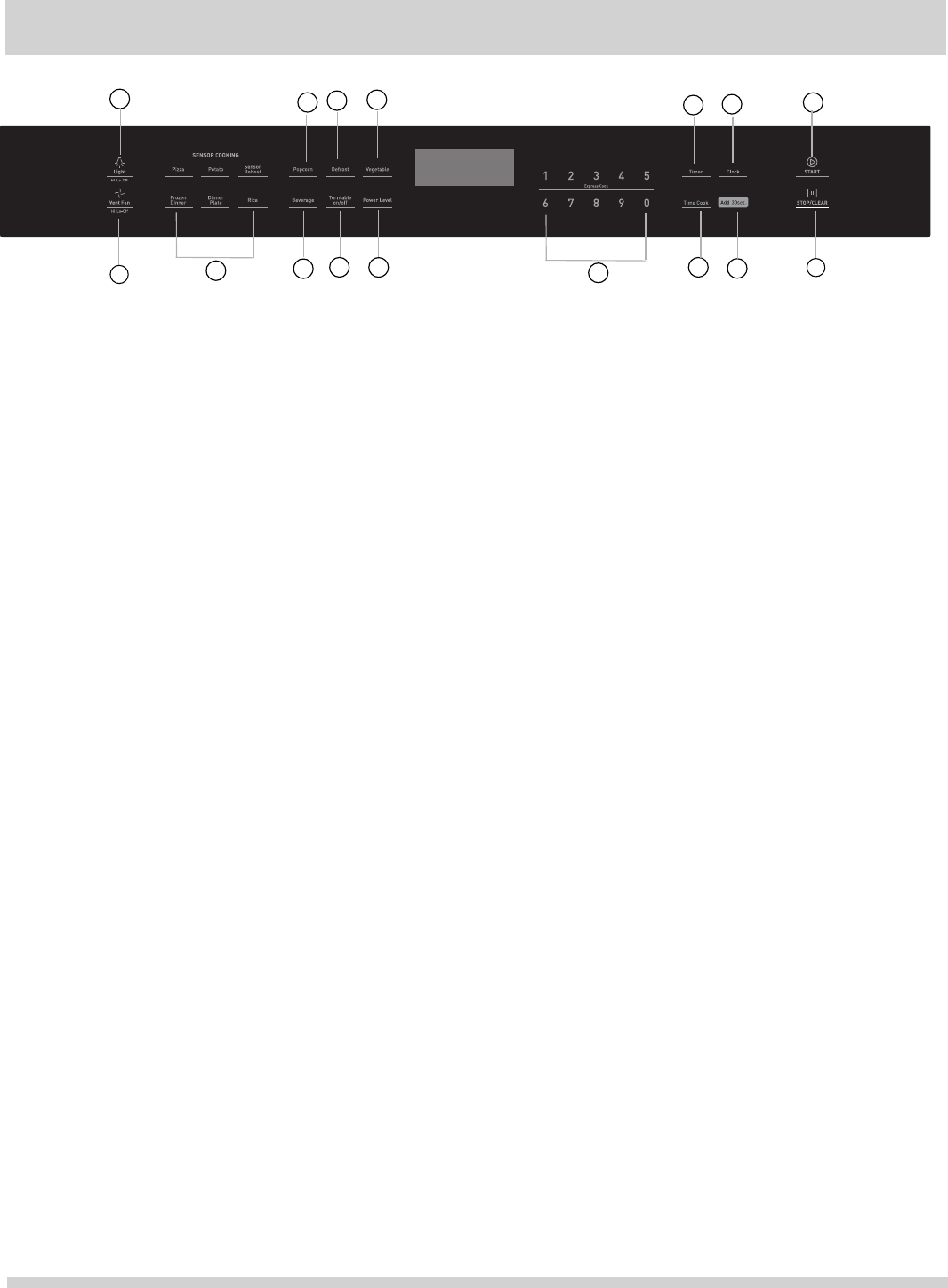
9
CONTROL PANEL
OR7_NEW Model_EN-4.indd 9 09.4.28 11:46:21 AM
Note:For detailed information,please go to relative page list above.
11 12
5
469
7
10
12 14
15
8
13
(11)
(12)
(13)
(14)
(15)
(1)
(2)
(3)
(4)
(5)
(6)
(7)
(8)
(9)
(10)
3
START
Numeric pads (0 thru 9)
Popcorn
Beverage
Defrost ( by weight)
Clock
Timer
Cook Time
Power
Level (10 power levels
available)
Stop/Clear
16
(16)
Vegetable
Turntable On/Off
+30 sec
Surface Light ~ Press this pad
surface lights on
or off.
to turn the
Vent Fan (High/Low/Off)
Sensor Cooking(Pizza,Potato,
Sensor Reheat,Frozen Pizza,
Dinner Plate and Rice)
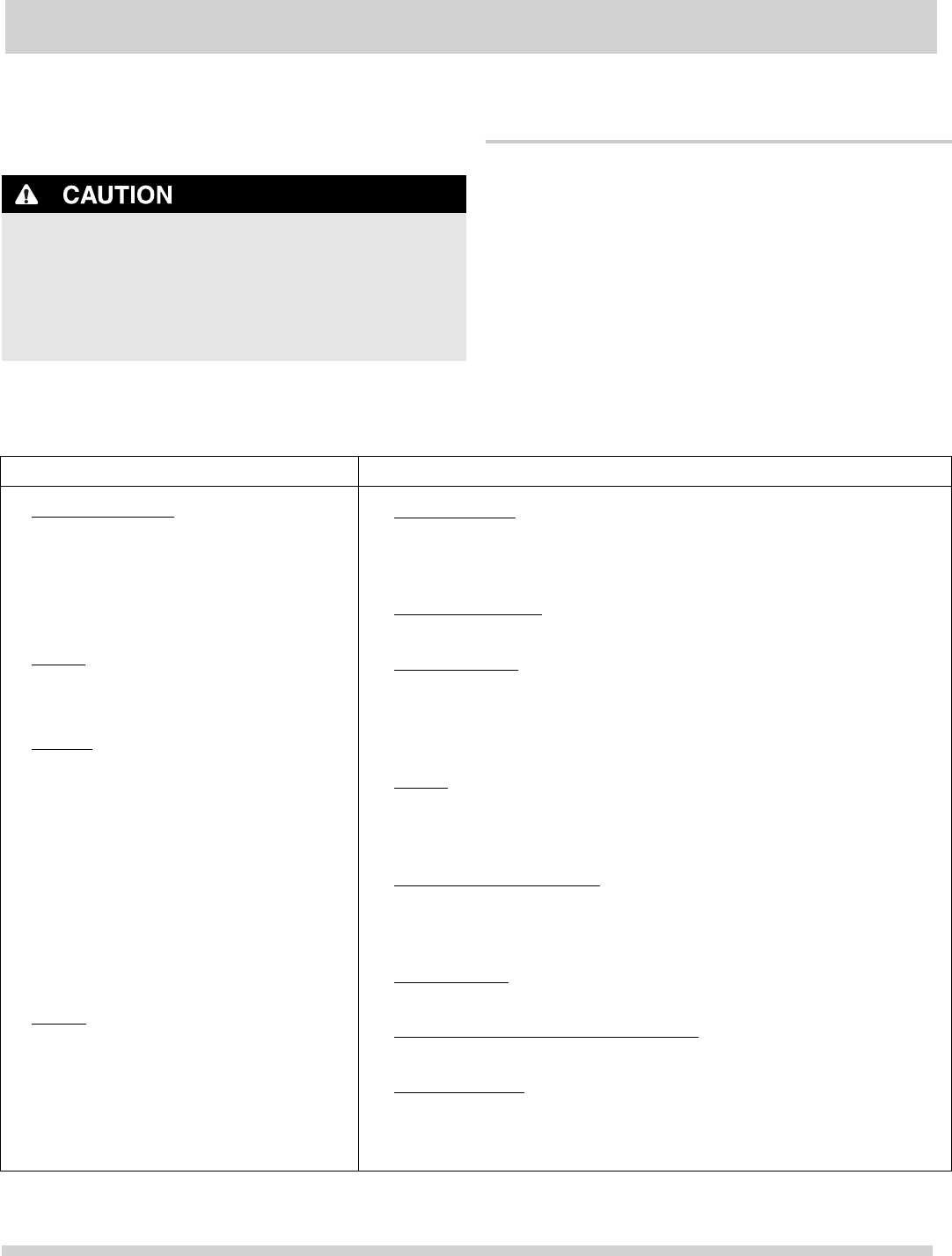
Learn more about your
microwave oven
•To avoid risk of personal injury or property damage, do
not operate the microwave oven empty.
•To avoid risk of personal injury or property damage, do
not use stoneware, aluminum foil, metal utensils, or
metal trimmed utensils in the microwave oven.
Setting the clock
Example: setting clock display for 10:12:
1. Touch Clock
2. Enter time using number pads.
3. Touch pad again.
Microwave utensil guide
•Oven proof glass (specifically treated
for high intensity heat):
Utility dishes, loaf dishes, pie plates,
cake plates, liquid measuring cups,
casseroles and bowls without metallic
trim.
•China:
Bowls, cups, serving plates and platters
without metallic trim.
•Plastic:
Plastic wrap (as a cover) - lay the plastic
wrap loosely over the dish and press it to
the sides. Vent plastic wrap by turning
back one edge slightly to allow excess
steam to escape. The dish should be
deep enough so that the plastic wrap will
not touch the food. Use plastic dishes,
cups, semi-rigid freezer containers and
plastic bags for short cooking times. Use
these with care because the plastic may
soften from the heat of the food.
•Paper:
Paper towls, waxed paper, paper napkins
and paper plates with no metallic trim or
design. Look for the manufacturer’s label
for any special instructions for use in the
microwave oven.
•Metal utensils:
Metal shields the food from microwave energy and produces uneven
cooking. Also, avoid metal skewers, thermometers or foil trays. Metal
utensils can cause arcing, which can damage your microwave oven.
•Metal decoration:
Bowls, cups, serving plates and platters without metallic trim.
•Aluminum foil:
Avoid large sheets of aluminum foil because they hinder cooking and
may cause harmful arcing. Use small pieces of foil to shield poultry
legs and wings. Keep ALL aluminum foil at least 1 inch from the side
walls of the oven cavity and door of the microwave.
•Wood:
Wooden bowls and boards will dry out and may split or crack when
you use them in the microwave oven. Baskets made of wood will react
in the same way.
•Tightly covered utensils:
Be sure to leave openings for steam to escape from covered
cookware. Pierce plastic pouches of vegetables or other food items
before cooking. Tightly closed pouches may explode.
•Brown paper:
Avoid using brown paper bags. They absorb heat and can burn.
•Flawed or chipped cooking utensils:
Any utensil that is cracked, flawed or chipped may break in the oven.
•Metal twist ties:
Remove metal twist ties from plastic or paper bags. They become hot
and could cause a fire.
Use Do not use
pad once.
BEFORE OPERATING
10
Start
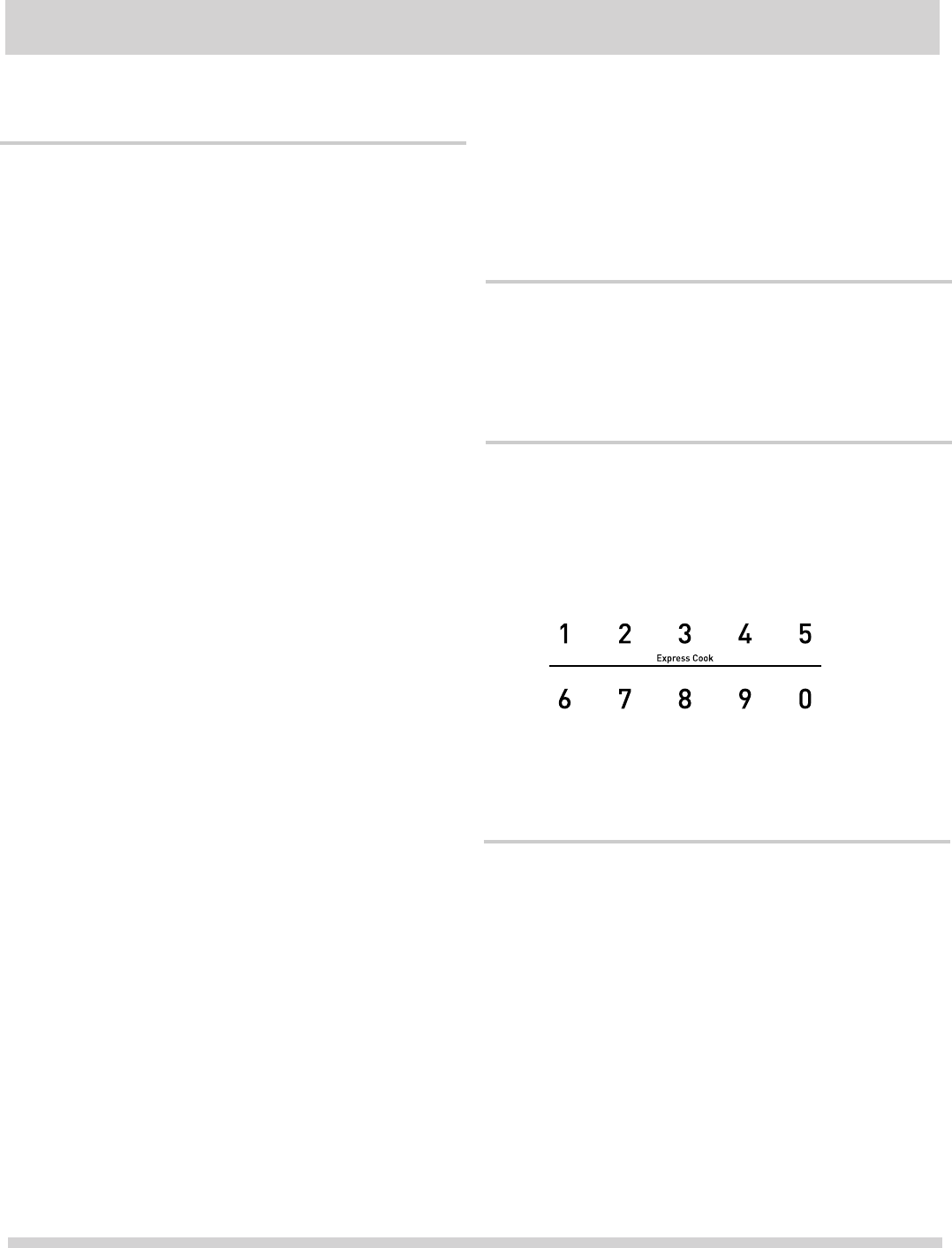
Setting the timer
Example: setting timer for 5 minutes:
1. Touch Timer pad once.
2. Enter desired time using number pads.
3. Touch pad.
When the timer has reached the end of set time, you will
hear beep alerts indicating the timer has run out.
Exhaust High / Low / Off
The exhaust ventilation moves steam and other cooking
vapors from the cooking surface of the range below the
microwave oven.
To operate the exhaust vent, Touch the
pad once for the
highest speed setting. Touch the pad again to
choose the Low speed setting and a 3rd time
to turn the exhaust ventilation off.
Note: If the temperature gets too hot around the microwave
oven, the fan in the exhaust vent hood will automatically turn
automatically turn off when the internal parts are cool. When
this occurs, the vent cannot be turned off.
Surface Light / On / Off
Touch the pad
once for a cooking surface high light. Press the
pad again for low light. Press the pad three times
to turn the light off.
Control Lock
You may lock the control panel to prevent the microwave
from being accidentally started or used by children.
The control lock feature is very useful when cleaning the
control panel. The lock will prevent accidental programming
when wiping the control panel clean.
Example: to set the control lock ON:
Touch and hold the Stop/Clear pad for more
than 3 seconds. The Lock icon will appear in
the display window along with a long beep. hold for 3
seconds
Example: to quickly heat for 2 minutes at 100% power:
Touch number pads 1, 2....9 for desired
minutes of cook time.
Microwave heating or cooking may be quickly set at 100%
power level for 1, 2... 9 minutes. Use the number keys 1, 2
will only work using the 1, 2 ....9 numeric pads):
Defrost (by weight) feature.
Example: to change the control lock from ON to OFF:
Touch and hold the Stop/Clear pad for
more than 3 seconds. The Lock icon will
disappear in the display window. hold for 3
seconds
MANUAL COOKING
11
stop
cancel
stop
cancel
2
Note: the Ready Set function cannot be set when using the
Using Ready Set
on at the LOW setting to cool the oven. The fan will
Start
Vent Fan Hi-Lo-Off
Light Hi-Lo-Off
....9 to choose the desired minutes of cook time (this option
Turntable On/Off
For best cooking results, leave the turntable on.
It can be turned off for large dishes.
1.
Press START
Press the pad once.
pad.
Turntable On/Off
The turntable is off.
Press the pad twice.Turntable On/Off
The turntable is on.
2.
3.

Heating with multiple cooking stages
Example: to cook food for 3 minutes at 80% power and
then 50% power for 6 minutes 30 seconds:
For best results, some microwave recipes call for different
power levels or different lengths of time for cooking. Your
microwave may be set to change from one stage to another
automatically (2 stages maximum).
heating time for the 1st stage (cook
time may be set up to 99 minutes
and 99 seconds).
Power Level pad once.
level for the 1st stage. PL8 appears
in the display (80 % power).
heating time for the 2nd stage (cook
time may be set up to 99 minutes
and 99 seconds).
stage.
level for the 2nd stage. PL5 appears
in the display (50 % power).
START pad.
Heating with high power level
Example: to heat for 5 minutes at 100% power:
Use the number pads to enter
desired heating time (cook time may
be set up to 99 minutes and 99
seconds).
Touch START pad.
Heating with lower power levels
Example: to heat for 4 minutes at 70% power:
Use the number pads to enter desired
heating time (cook time may be set
up to 99 minutes and 99 seconds).
Press Power Level pad once for
power level 10 (100% power).
Use the number key to change the
power level to 7. PL7 appears in the
display (70 % power).
Press START pad.
Using the highest power level to heat foods with does not
always give the best results when some types of food need
slower cooking, such as roasts, baked goods or custards.
Your oven has nine other power levels you may choose.
"END" will display.
"END" will display.
"Good" will display.
Note:
Power level must always be programmed for first
stage - 100% =10.
When heating has finished you will hear beeps and
When heating has finished you will hear beeps and
When heating has finished you will hear beeps and
MANUAL COOKING
12
start
+ 30 sec
power
level
start
+ 30 sec
power
level
power
level
start
+ 30 sec
Press Power Level pad for 2nd
1.
2.
1.
2.
3.
4.
1. Use the number pads to enter
2. Press
3. Use the number keys to enter power
4. Use the number pads to enter
5.
6. Use the number key to enter power
7. Press

Example: to defrost 1lb. of food with the default power
level and cook time determined automatically:
Setting Defrost (by Weight)
1. Press Defrost
appear in the display.
of food to defrost in pounds (10 = 1lb.)
You may enter any weight from 0.1 to
6.0lbs.
"END" will display.
Note: The weight amount must be a valid entry for this
feature to start. A valid weight entry is 0.1 to 6.0 pounds.
When defrosting has finished you will hear beeps and
MANUAL COOKING
13
stop/clear
start
+ 30 sec
start
+ 30 sec
Press pad twice.
Press START pad.
This feature will let you quickly start or add 30 seconds
Touch the pad to :
time this pad is touched during microwave
cooking.
Start cooking
Extend cooking time in multiples of 30 seconds
each
start
+ 30 sec
This feature will let you quickly stop or cancel the cooking
process.
1.
Touch the pad to :
Start/+ 30 sec.
Using the key
stop
cancel
2.
3.
4.
5.
Canel timer.
Cancel a program during cooking, touch twice.
pad again to start
+ 30 sec
START
(Touch
resume cooking.)
Example: to add 1 minute of cook time during 80%
microwave cooking :
Erase if you have entered wrong information.
Press pad once to pause the oven
temporalily during cooking.
Return the time of day (clock) to the display
after cooking cycle is completed.
1. Start programmed cooking.
for 30 seconds at 100% power level.
2.
3.
Using the Stop/Cancel key
ADD 30SEC.
pad once.MEAT will
" repeatedly to choose the desired
function. And "MEAT", "POULTRY","FISH" or
2. Press "
"BREAD" will display in turn.
Defrost
3. Press START pad.
4. Use the numeric pads to input weight
5.
ADD 30SEC.
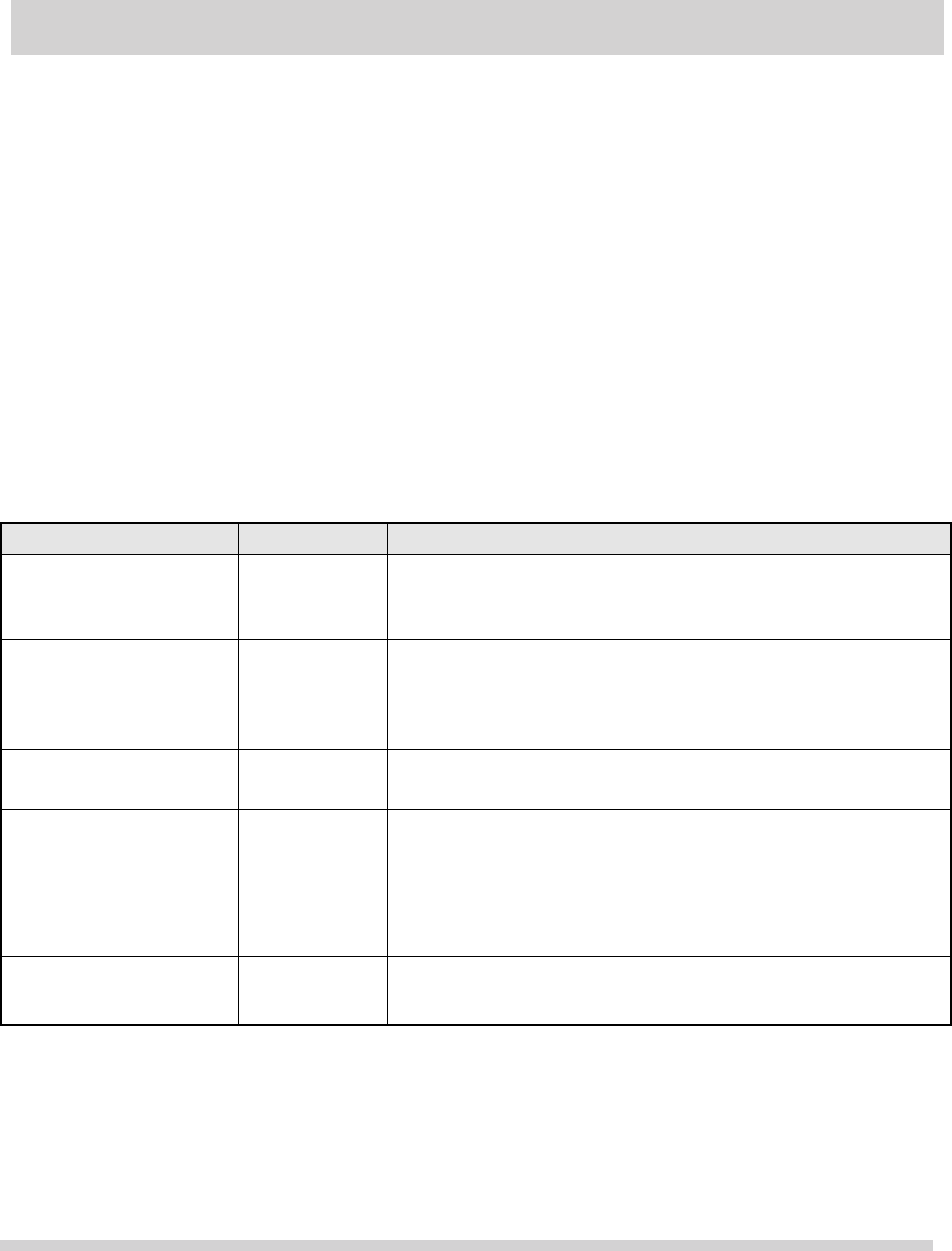
Defrosting tips
Defrosting suggestions for meats
For best results, please read these suggestions when defrosting meats.
• Roast beef or pork
• Steaks, chops or fish
• Ground meat
• Whole chicken
• Chicken pieces
Start with the food placed fat side down. After each stage, turn the
food over and shield any warm portions with narrow strips of aluminum
foil. Let stand, covered for 15-30 minutes.
After each stage, rearrange the food. If there are any warm or thawed
portions of food, shield them with narrow flat pieces of aluminum foil.
Remove any pieces of food that are nearly defrosted. Let stand,
covered for about 5 to 10 minutes.
After each stage, remove any pieces of food that are nearly defrosted.
Let stand, covered with foil for 5 to 10 minutes.
Remove giblets before freezing poultry. Start defrsoting with the
breast side down. After the 1st stage, turn the chicken over and
shield any warm portions with narrow strips of aluminum foil. After the
2nd stage, again shield any warm portions with narrow strips of
aluminum foil. Let stand, covered, for 30 to 60 minutes in the
refrigerator.
After each stage, rearrange or remove any pieces of food that are
nearly defrosted. Let stand for 10-20 minutes.
Meat Normal amount Suggestions
•When using the defrost weight feature, the weight
entered should always be pounds (valid entries are from
0.1 to 6.0 pounds).
•Use both defrost weight features for
raw food items only. Defrosting gives best results when
food to be thawed is a minimum of 0°F (taken directly
from a true freezer). If the food has been stored in a
refrigerator-freezer that does not maintain a temperature
of 5° F or below, always program a lower food weight or
lower cook time to prevent cooking the food.
•If the frozen food is stored outside the freezer for up to 20
minutes, enter a reduced cook time or weight.
•The shape of the package will alter the defrosting time.
Shallow rectangular food packets defrost more quickly
than a deep frozen block of food.
•Separate pieces as they begin to defrost. Separated
frozen pieces of food defrost better.
•Shield warm areas of food with small pieces of foil if they
start to become warm.
•You may use small pieces of aluminum foil to shield food
items like chicken wings, leg tips and fish tails, but do
not allow the foil to touch the oven cavity walls when
defrosting.
(40 to 96 oz.)
(8 to 48 oz.)
0.5 to 3 lbs.
(8 to 48 oz.)
0.5 to 3 lbs.
(40 to 96 oz.)
2.5 to 6 lbs.
(8 to 48 oz.)
0.5 to 3 lbs.
2.5 to 6 lbs.
MANUAL COOKING
14

MANUAL COOKING
15
Sensor Reheat
The sensor reheat feature is designed to detect the
increasing humidity released by the food during the cooking
process. The microwave oven sensor will automatically
adjust the cooking time to the type and amount of food.
The food types to avoid using with the reheat feature are:
Uncooked or raw foods.
Bread and other dry types of food such as crackers,
biscuits, or cakes.
Notes concerning sensor reheat:
For casseroles, add 2-3 tablespoons of liquid, cover
with lid or vented plastic wrap. Stir when instructed
from display.
For canned foods, empty contents of can into a
casserole dish or serving bowl. Cover dish with lid or
vented plastic wrap. Let stand a few minutes before
serving.
For plates of food, arrange food on plate and add any
butter or gravies, etc. Cover with loose-fitting lid or
vented plastic wrap. After reheating, let stand a few
minutes be
Example: to reheat (sensor) automatically:
1. Press Sensor Reheat pad once . Sensor detects vapor
emitting from food to determine remaining cooking time
and then press START starts.
automatically
1.
When finished, you will hear 5 beeps. If additional
time is needed, continue cooking manually.
NOTE: Be sure to separate the slices before cooking.
2. STARTPress
Pizza
The pizza sensor feature cooks from 6-12 Oz.of pizza
(when starting at minus 18 C
°(-0.4 F) ).
°
Press the Pizza pad.
1.
2. Press START
When finished, you will hear a series of beeps. If additional
time is needed, continue cooking manually.
Notes:
Before cooking, pierce potato skins with fork 5-6 times.
Place potatoes around the edge of a paper towel-lined
turntable.
Do not cover potatoes.
Let potatoes stand for about 5 minutes after the micro-
wave has finished to complete the cooking process.
Potato
The potato feature cooks 8-32 oz. of potatoes automatically
(starting from room temperature).
Press the Potato pad.
The frozen dinner sensor setting is designed for single
frozen en tress or frozen convenience foods such as frozen
dinners from 8 to 32 oz. In size (starting with frozen dinner
Frozen Dinner
1.
2. Press START
Notes:
ALWAYS be sure to follow the directions that are
specific for the microwave oven that is printed on the
packaging for the food being prepared. Many times
there are special instructions to follow in order to
achieve best results.
Be sure to allow for moisture to escape from the
packaging. All frozen entree instructions specify that
you poke holes in the film covering with a fork before
cooking.
Be careful when removing the film covers after cooking
frozen convenience foods. Remove facing away from
you to avoid steam burns.
If the food is not done when the cook time is done, fin-
ish cooking manually.
When finished, you will hear a series of beeps. If additional
time is needed, continue cooking manually.
temperature at minus 18°C (-0.4 F) ).
°
Press the Frozen Dinner pad.
pad.
pad.
pad.
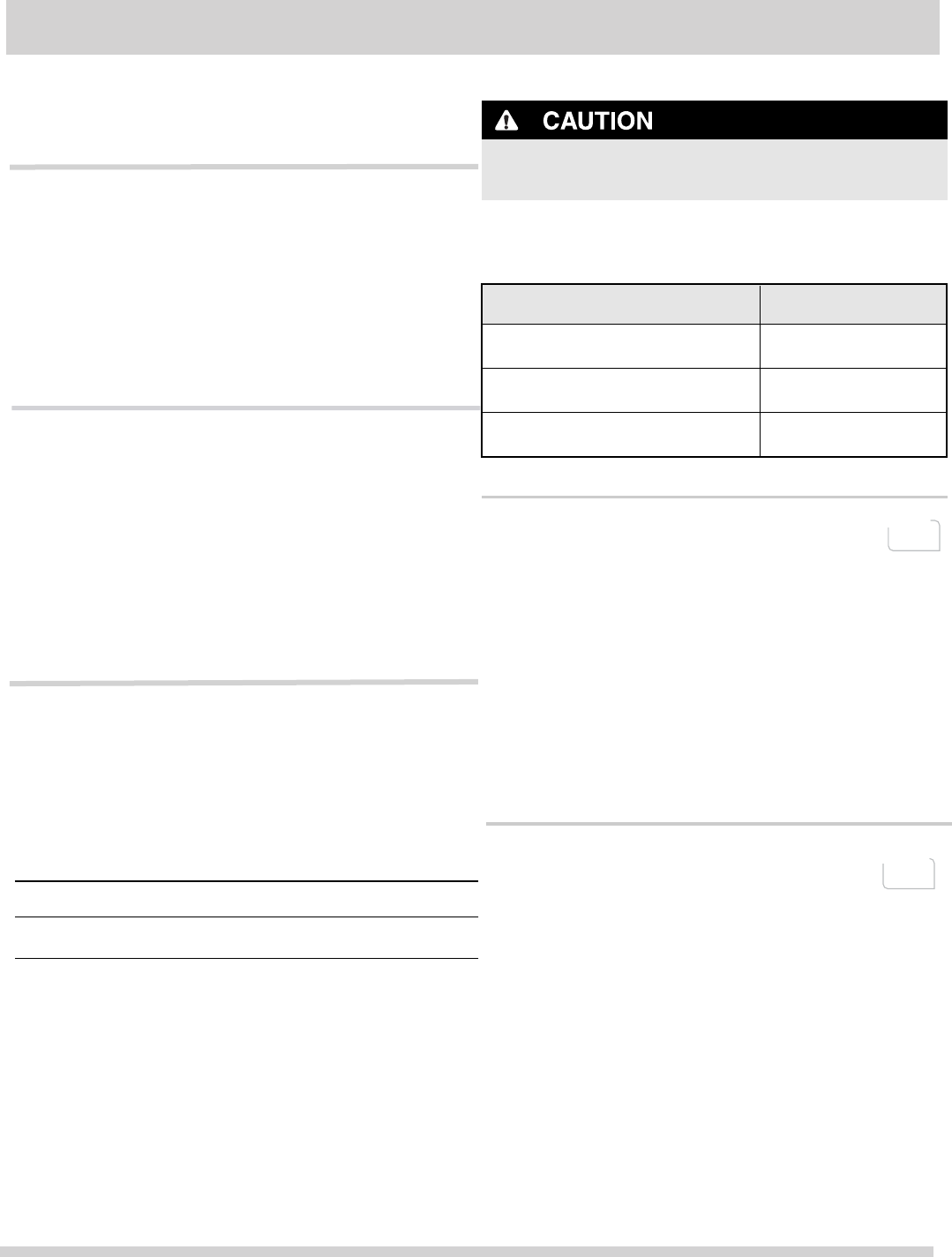
MANUAL COOKING
16
The dinner plate sensor setting is designed for single
convenience foods.
1.
2. Press START
Press the
Dinner Plate
Dinner Plate pad.
pad.
1.
2. Press START
When finished, you will hear a series of beeps. If additional
time is needed, continue cooking manually.
The rice feature cooks rice automatically
(starting from room temperature).
Press th
pad.
Rice
e pad.
Rice
When finished, you will hear a series of beeps. If additional
time is needed, continue cooking manually.
The Veggie sensor feature cooks from 1 to 4 servings. Of
fresh vegetables (when starting at room temperature).
Vegetable
1.
Press START
Press the Vegetable pad once.
to choose fresh vegetable.
Press the Vegetable pad twice.
to choose frozen vegetable.
2.
pad.
Food Weight range
Press button
1
2 Frozen Vegetable
Fresh Vegetable 1- 4 servings
1- 4 servings
3.
1. Press Popcorn pad (1, 2 or 3 times - refer
to table above to change for bag size).
2. Press START pad.
Popcorn
• DO NOT leave micowave oven unattended while
popping corn.
The popcorn feature lets you pop 3 different commercially
packaged microwave popcorn sized bags. Use the table
below to determine the setting to use.
Example: to pop a 3.0 oz. bag of popcorn automatically.
Amount
3.0 oz.
Press popcorn pad
once
2 times
3 times
The microwave will beep when finished. start
+ 30 sec
start
+ 30 sec
popcorn
3.3 oz. (default setting)
1.75 oz.
Beverage
1. Press Beverage pad (1, 2 or 3 times -
refer to table above to change number of
servings).
2. Press START pad.
The beverage feature heats 1, 2 or 3 cups of beverage. Use
the table below to determine the setting to use.
Example: to heat 1 cup of a beverage.
The microwave will beep when finished.
start
+ 30 sec
start
+ 30 sec
beverage
3. Press number keys to choose cups.
START pad.
4. Press
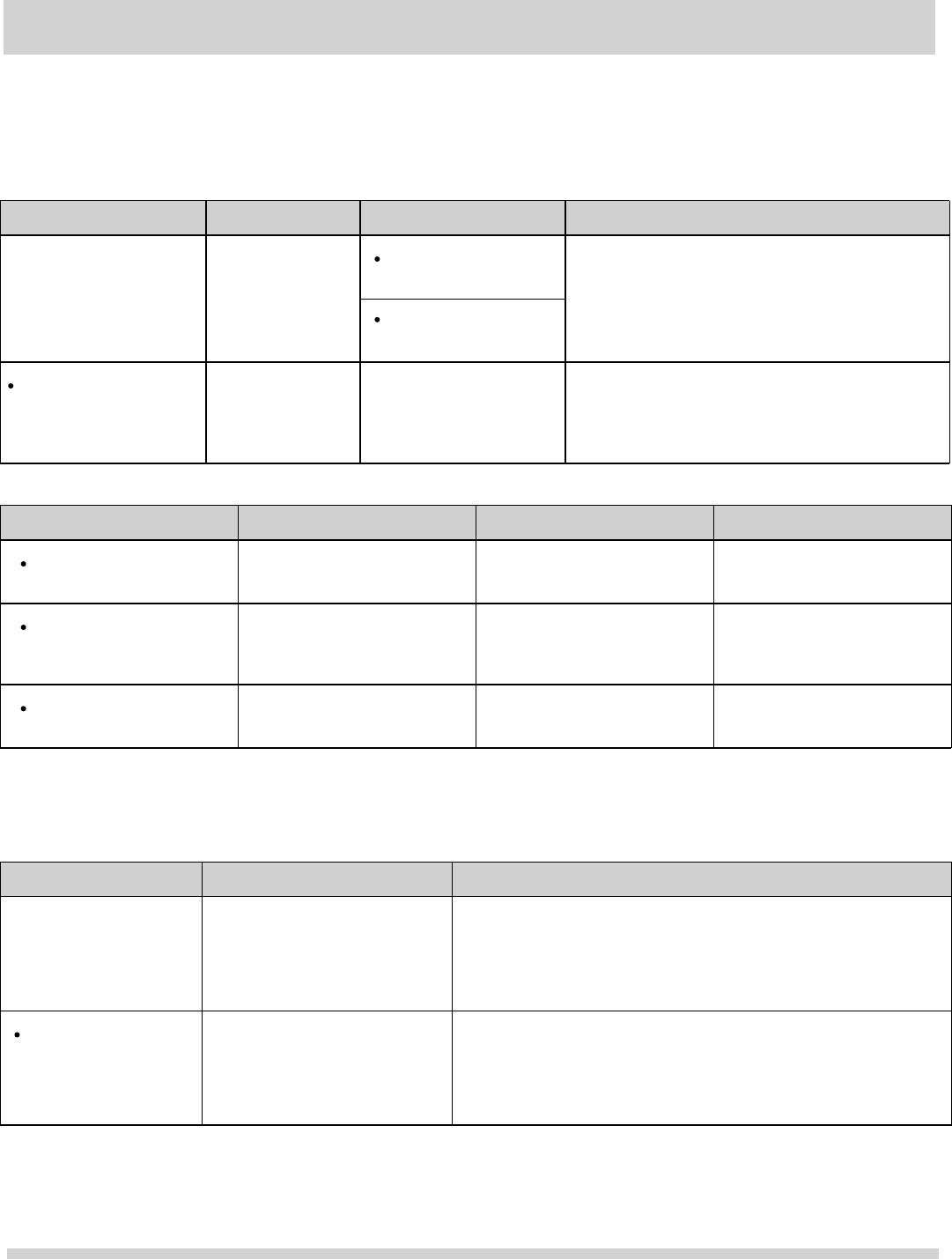
MANUAL COOKING
17
Be sure to place prepared meats on a microwave-safe roasting rack in a microwave-safe dish. Start cooking the meat fat
side down and if necessary, use narrow strips of aluminum foil to shield any bone tips or thin meat areas. After cooking,
check the temperature in several places before letting the meat stand the recommended time. Please note that the
temperatures in the following charts are temperature at removal time; the temperature will rise during the standing period.
* Expect a 10° F rise in the temperature during the standing period.
Be sure to place poultry on a microwave-safe roasting rack in a microwave-safe dish. Cover poultry with wax paper to
prevent splattering. Use narrow strips of aluminum foil to shield any bone tips or thin meat areas, or areas that start to
overcook. After cooking, check the temperature in several places before letting the meat stand the recommended time.
Cooking meat in your microwave
Meat Power level Cook time Directions
Roast beef boneless
(up to 4 lbs.)
High (10) for
first 5 minutes,
then medium (5)
12-17 min./lb. For
160° F (Medium)
14-19 min./lb. For
170° F (Well Done)
Place roast beef fat-side down on roasting rack.
Cover with wax paper. Turn over half way
through cooking. Let stand * 10-15 minutes.
Roast pork boneless
or bone-in
(up to 4 lbs.)
High (10) for
first 5 minutes,
then medium (5)
15-20 min/lb. For 170°
F(Well Done)
Place roast pork fat-side down on roasting rack.
Cover with wax paper. Turn over half way
through cooking. Let stand * 10-15 minutes.
Meat Doneness Remove from oven After standing (10-15 min.)
Beef Medium
Well Done
150° F
160° F
150° F
160° F
Pork Medium
Well Done
150° F
160° F
150° F
160° F
Poultry Dark meat
Light meat
170° F
160° F
170° F
160° F
Cooking poultry in your microwave
Poultry Cook time / power level Directions
Whole chicken
(up to 4 lbs.)
Cook time: 7-10 min. / lb.
180° F dark meat
170° F light meat
Power level: medium high (7)
Place chicken breast-side down on roasting rack. Cover with
wax paper. Turn over half way through cooking. Cook until
juices run clear and meat near bone is no longer pink. Let
stand for 5-10 min.
Chicken pieces
(up to 4 lbs.)
Cook time: 7-10 min. / lb.
180° F dark meat
170° F light meat
Power level: medium high (7)
Place chicken bone-side down on dish, with thickest portions
toward the inside of dish. Cover with wax paper. Turn over
half way through cooking. Cook until juices run clear and meat
near bone is no longer pink. Let stand for 5-10 min.
Never cook eggs in the shell and never warm hard-
cooked eggs in the shell; they can explode.
Always pierce whole eggs to keep them from bursting.
Cook eggs just until set; they will become tough if
overcooked.
Cooking eggs in your microwave
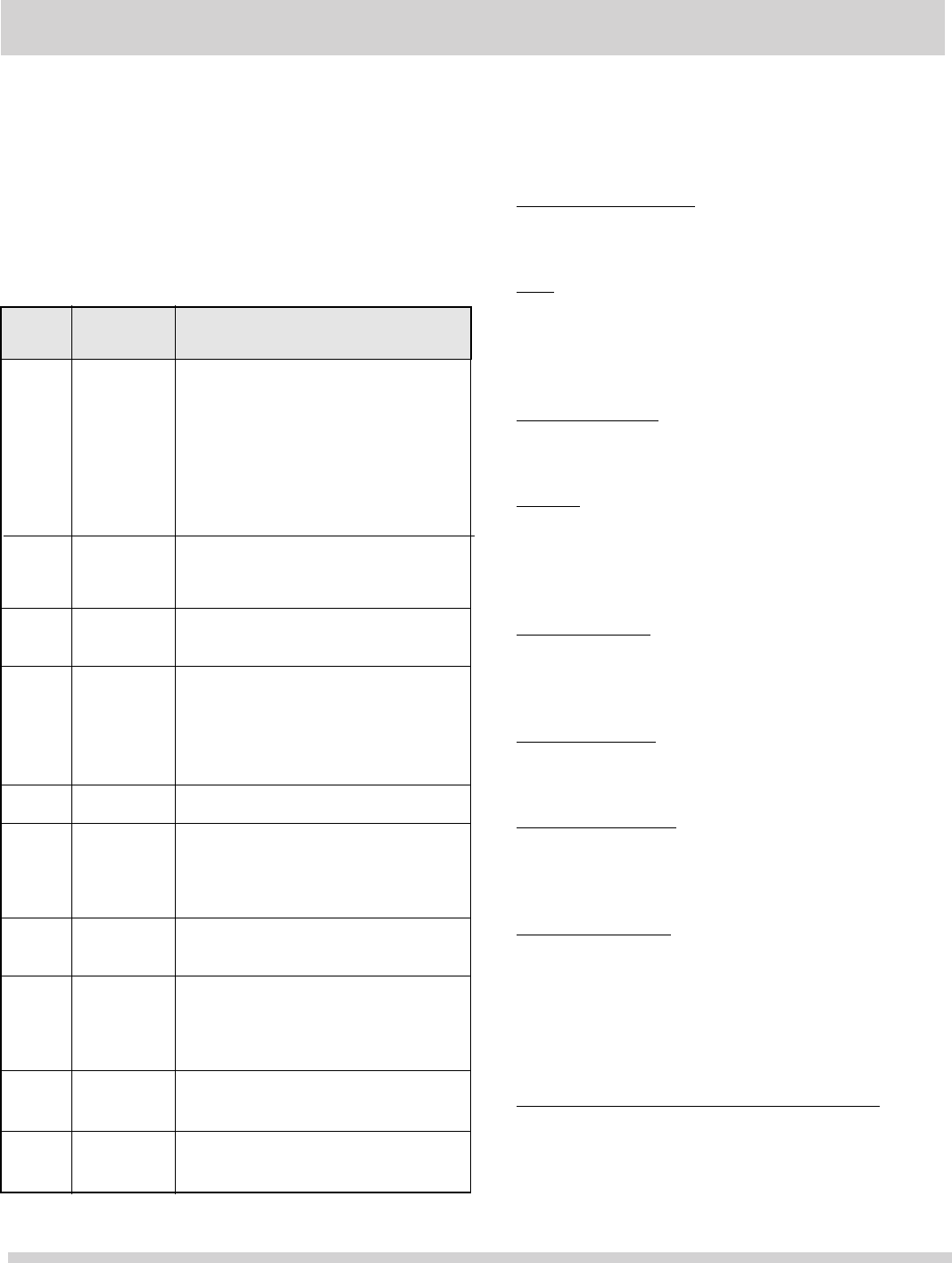
•
AUTO COOKING
18
Suggested power levels for cooking
The 10 power levels available with this microwave will help
you to adjust to the power output best suited for the food
type you are preparing. As with any food prepartion in the
microwave, it is best to follow the microwave instructions
that are printed on food packaging.
The table below provides suggested power levels for various
types of food that you can be prepare in the microwave.
Suggestions for getting
the best results
•Storage temperature
Foods taken from the freezer or refrigerator take longer to
cook than the same foods would at room temperature.
•Size
Small pieces of food cook faster than large ones. Pieces
similar in size and shape will cook more evenly when
cooked together. For more even results, reduce the
power levels when cooking large pieces of food.
•Natural moisture
Very moist foods cook more evenly because microwave
energy heats water molecules very efficiently.
•Stirring
Stir foods such as casseroles and vegetable from the
outside to the center to distribute the heat more evenly.
This will allow the food to cook faster. Constant stirring is
not necessary.
•Turn over items
Turn over foods such as pork chops, roasts or whole
cauliflower halfway through the cook time. This will help
to expose all sides equally to microwave energy.
•Food placement
Place delicate areas of food items, such as asparagus
tips, toward the center of the turntable tray.
•Food arrangement
Arrange unevenly shaped foods, such as chicken pieces
or salmon, with the thicker or meatier parts toward the
outside of the turntable tray.
•Let the food stand
After removing the food from the microwave, cover the
food with foil or a casserole lid and let it stand to finish
cooking. This will help the food finish in the center and
avoids overcooking the out edges, The length of stand
time depends on the density and surface area of the food
items.
•Wrapping in paper towels or waxed paper
Sandwiches and many other food types containing pre-
baked bread should be wrapped prior to placing in the
microwave to help prevent the food items fro drying out
while heating.
To help you achieve the best possible results from your
microwave oven, read the following suggestions below;
Power
level
Microwave
output
• Boiling water.
• Cooking ground beef.
• Making candy.
• Cooking fresh fruits & vegetables
• Cooking fish & poultry.
• Preheating browning dish.
• Reheating beverages.
• Cooking bacon slices.
• Reheating meat slices quickly.
• Saute onions, celery & green
peppers.
• All reheating.
• Cooking scrambled eggs.
• Cooking breads & cereal
products.
• Cooking cheese dishes & veal.
• Cakes, muffins, brownies &
cupcakes.
• Cooking pasta.
• Cooking meats & whole poultry.
• Cooking custard.
• Cooking spare ribs, rib roast &
sirloin roast.
• Cooking less tender cuts of meat.
• Reheating frozen packaged foods.
• Thawing meat, poultry & seafood.
• Cooking small quantities of food.
• Finish cooking casseroles, stew &
some sauces.
• Softening butter & cream cheese.
• Heating small amounts of food.
• Softening ice cream.
• Raise yeast dough.
Use to prepare when:
10
High
9
8
7
6
5
4
3
2
1
100 %
90 %
80 %
70 %
60 %
50 %
40 %
30 %
20 %
10 %
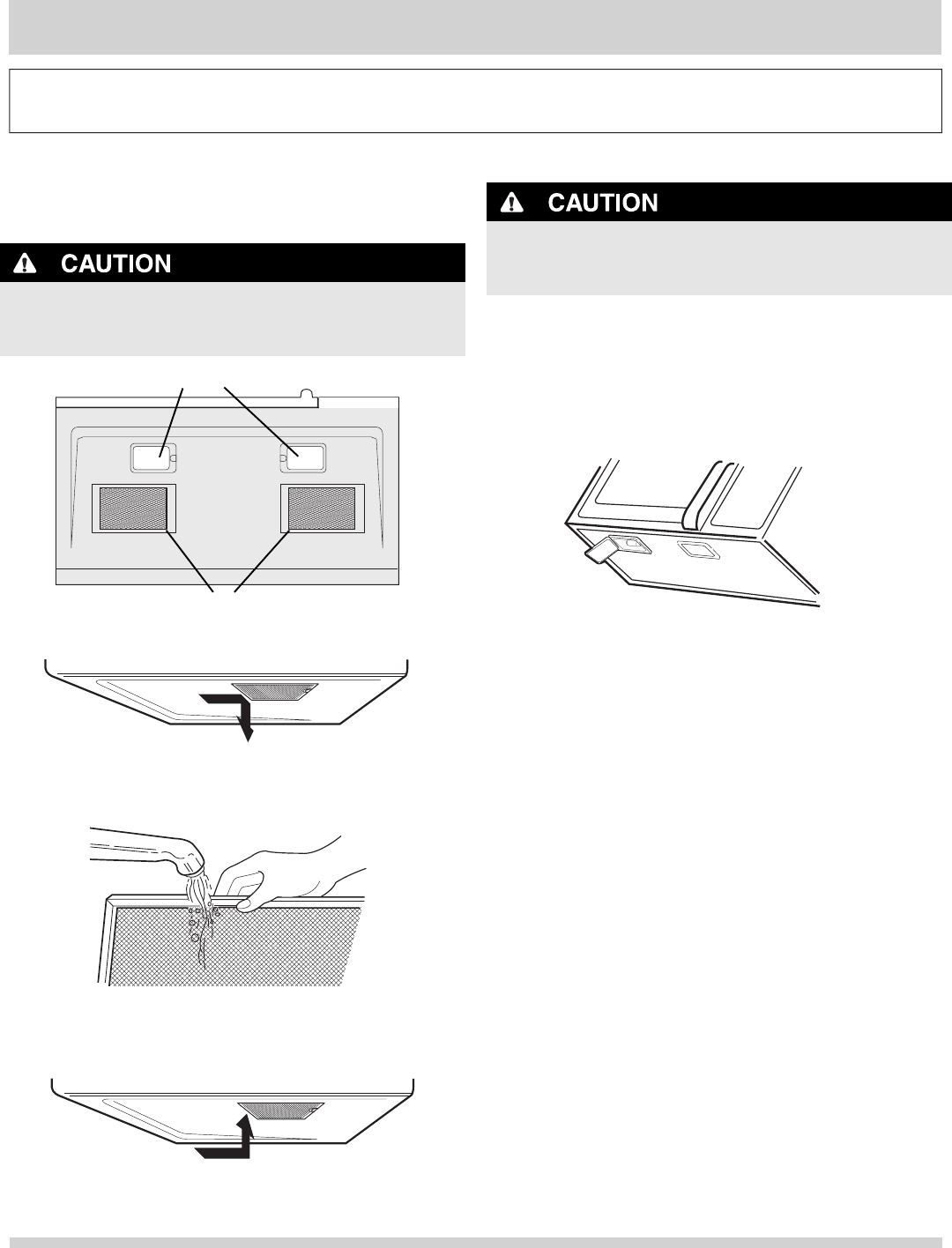
To avoid risk of personal injury or property damage, do
not operate oven hood without filters properly in place.
Cleaning the exhaust filters
The oven ventilation exhaust filters should be removed and
cleaned often; generally at least once every month.
1. To remove the exhaust ventilation filters, slide the filter to
the rear. Then pull filter downward and push to the other
side. The filter will drop out. Repeat for the 2nd filter.
3. To reinstall the exhaust ventilation filter, slide it into the
side slot, then push up and toward oven to lock.
Reinstall the 2nd filter using the same procedure.
Front
Rear
Surface lights
Ventilation
filters
Surface light replacement
To avoid risk of personal injury or property damage, wear
gloves when replacing the light bulbs.
1. Unplug the microwave oven or turn off power at the main
circuit breaker.
2. Remove the LED cover mounting screws at both light
positions under the microwave.
3. Replace bulb with new LED lights.
4.
5. Plug the microwave back into the power supply or turn
the power back on at the main circuit breaker.
Re-install new LED lights cover and mounting screw.
CLEANING AND CARE
Disconnect the power cord before cleaning or
leave the door open to deactivate the oven during cleaning.
2. Soak the ventilation filters in hot water using a mild
detergent. Rinse well and shake to dry
Do not use ammonia. The aluminum
on the filter will corrode and darken.
or wash in
a dishwasher.
19
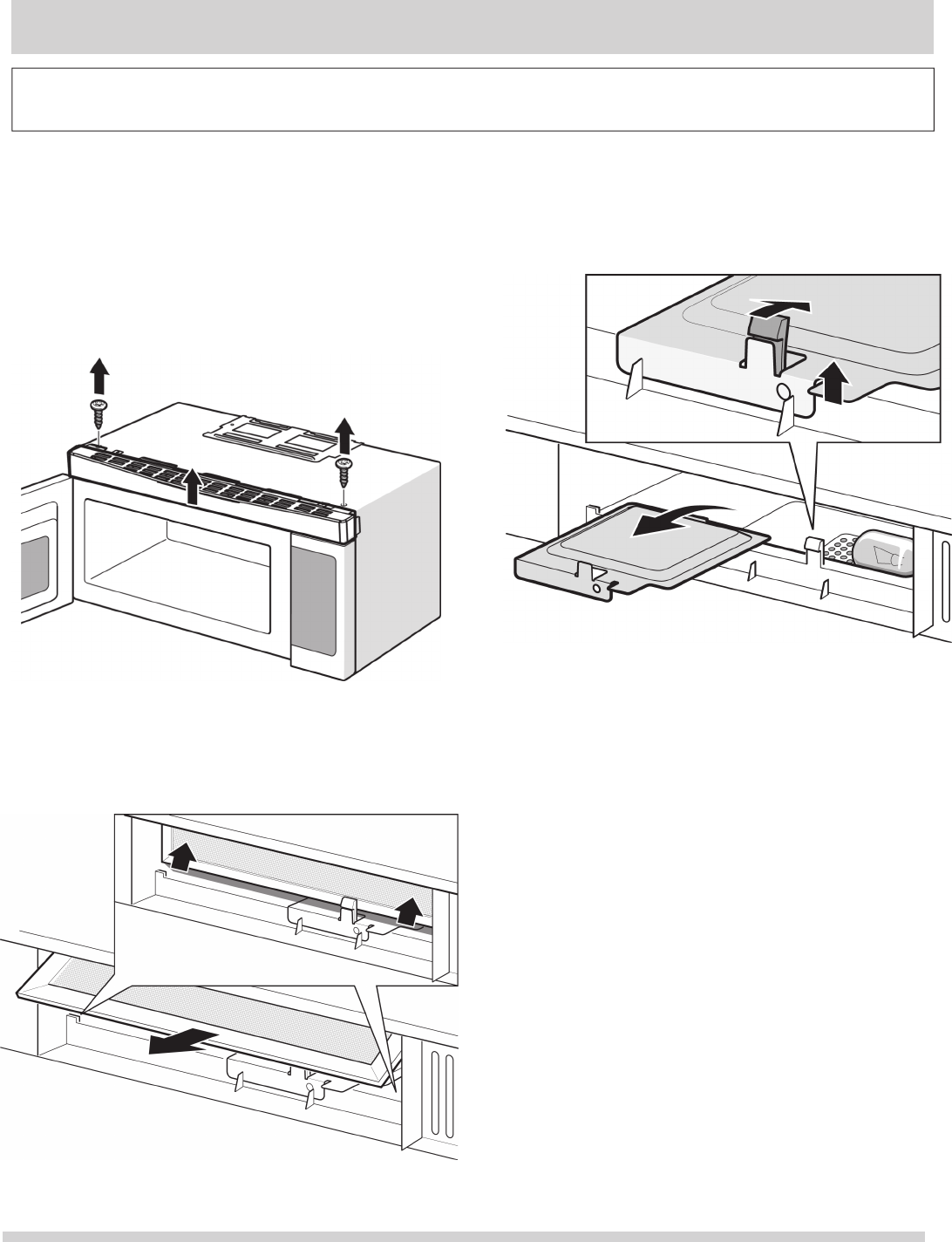
2. Remove the vent grill mounting screws.
3. Pull the vent grill away from the unit.
4.Remove the charcoal filter by pushing it inwards,
then turn and pull it away from the unit.
pulling up on the front edge.
equivalent LED lights available from parts
distributor. LED lights are also available at most
hardware stores or lighting centers.
carefully pushing into place. Replace the
charcoal filter. Push the vent grill back into
place (engaging both the bottom and top tabs)
and replace the vent grill mouting screws.
carefully
CLEANING AND CARE
20
Charcoal filter replacement
Charcoal Filter installed in your microwave oven, is used
for nonvented, recirculated installation. The filter should
be changed every 6 to 12 months depending on use.
1. Disconnect power to the microwave oven at the circuit
breaker panel or by unplugging.
Remove the per instructions 1-4 above and
charcoal filter, if used.
1. Open light cover located behind filter mounting by
3. Replace the microwave oven light cover by
Oven light replacement
vent grill
Disconnect the power cord before cleaning or
leave the door open to deactivate the oven during cleaning.
2. Remove old LED lights and replace only with

For best performance and for safety reasons, keep the oven
clean inside and outside. Take special care to keep the
inner door panel and oven fron frame free of food and grease
build-up.
Never use rough scouring powder or pads on the
microwave. Wipe the microwave oven inside and out with a
soft cloth and and warm (not hot) mild detergent solution.
Then rinse and wipe completely dry.
Wipe spatters immediately with a wet paper towel,
especially after cooking greasy foods like chicken or bacon.
Clean your microwave oven weekly or more often, if needed.
Follow these instructions to clean and care for your
microwave oven:
Cleaning suggestions
•Keep the inside (cavity) of the oven clean. Food particles
and spilled liquids can stick to the oven walls, causing
the oven to work less efficiently.
•Wipe up spills immediately. Use a damp, clean cloth
and mild soap. DO NOT use harsh detergents or
abrasive cleaners.
•To help loosen baked-on food particles or liquids, heat 2
cups of water (add the juice of 1 lemon if you desire to
keep the oven fresh smelling) in a 4 cup measuring glass
at High power for 5 minutes or until boiling. Let stand in
oven cavity for 1 or 2 minutes.
•Remove the glass turntable tray from the oven when
cleaning the oven cavity or tray. To prevent the glass
turntable from breaking, handle with care and do not put
it in water immediately after cooking. Wash the turntable
tray in warm sudsy water or in the dishwasher.
•Clean the outside surface of the microwave with soap
and a clean damp cloth. Dry with a clean soft cloth. To
prevent damage to the operating parts of the oven, do not
let water seep into any vents or openings.
•Wash the oven door window with very mild soap and
water. Be sure to use a soft clean cloth to avoid
scratching.
•If steam accumulates inside or outside the oven door,
wipe with a soft cloth. Steam can accumulate when
operating the oven in high humidity and in no way
indicates microwave leakage.
•Never operate the oven without food in the oven cavity;
this can damage the magnetron tube or glass tray. You
may wish to leave a cup of water standing inside the oven
when it is not in use to prevent damage if the oven is
accidentally turned on.
CLEANING AND CARE
21
Disconnect the power cord before cleaning or
leave the door open to deactivate the oven during cleaning.
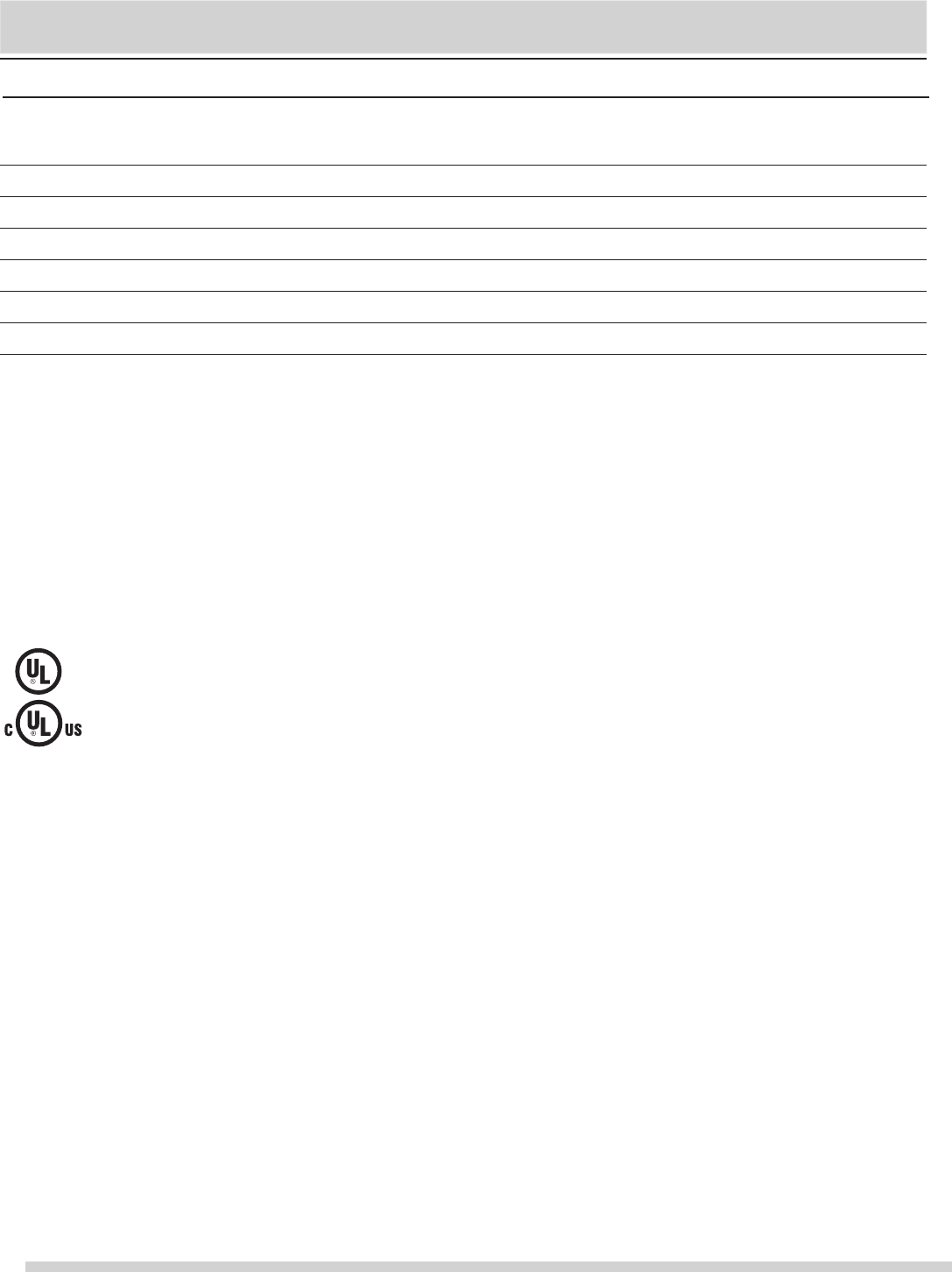
22
SPECIFICATIONS
* The International Electrotechnical Commission’s standardized method for measuring output wattage. This test method
is widely recognized.
**
This is the classification of ISM (Industrial, Scientific and Medical) equipment described in the International Standard CISPR11.
***
Internal capacity is calculated by measuring maximum width, depth and height. Actual capacity for holding food is less.
In compliance with standards set by:
FCC - Federal Communications Commission Authorized.
DHHS -
Complies with Department of Health and Human Services (DHHS) rule, CFR, Title 21, Chapter I, Subchapter J.
- This symbol on the nameplate means the product is listed by Underwriters Laboratories, Inc.
- This symbol on the nameplate means the product is listed by Underwriters Laboratories, Inc. for use in
USA
or Canada.
Approx. (net) lb, (gross) lb
AC Line Voltage: Single phase 120V, 60Hz, AC only
AC Power Required:
29.88”(W) x 16.42”(H) x
1550W
1.6 Cu.Ft.
Output Power*: 1000 W
Frequency: 2450 MHz (Class B/Group2)**
Outside Dimensions : 15.04”(D)
Microwave oven Capacity***:
Cooking Uniformity: Turntable
Weight:
This product has been tested and found to comply with the limits for Microwave
Oven, pursuant to Part 18 of the FCC Rules.
This product can radiate radio frequency energy, which could cause interference to
such products as radio, TV, baby monitor, cordless phone, Bluetooth, wireless router,
etc., which can be confirmed by turning this product off and on. If present, the user is
encouraged to try to correct by taking one or more of the following
countermeasures:
(1) Increase the spacing distance between the microwave oven and other product
receiving the interference.
(2) If possible, use a properly installed receiver antenna and/or reorient the receiving
antenna of the other product receiving the interference.
(3) Plug the microwave oven into a different outlet from the other product receiving
the interference.
(4) Clean door and sealing surfaces of the oven. (See Care and Cleaning of Your
Microwave Oven)
FCC Caution.